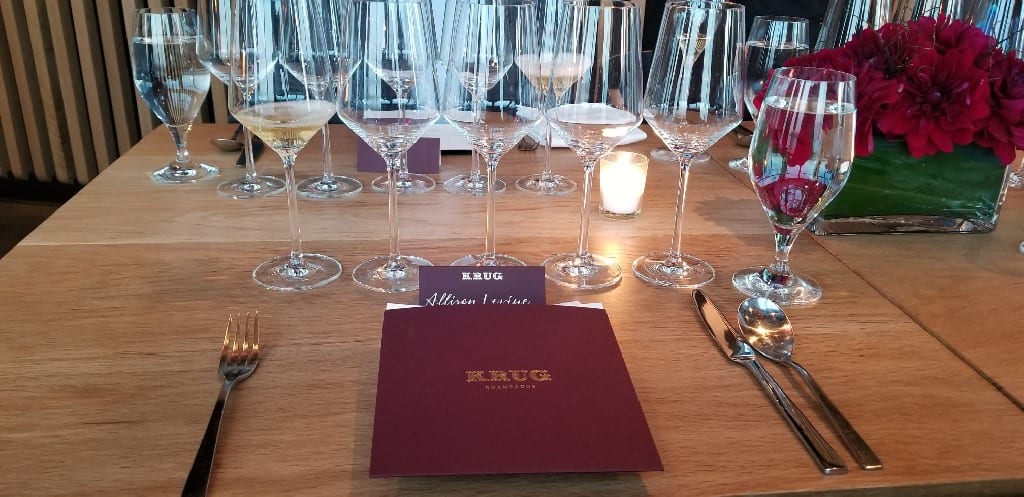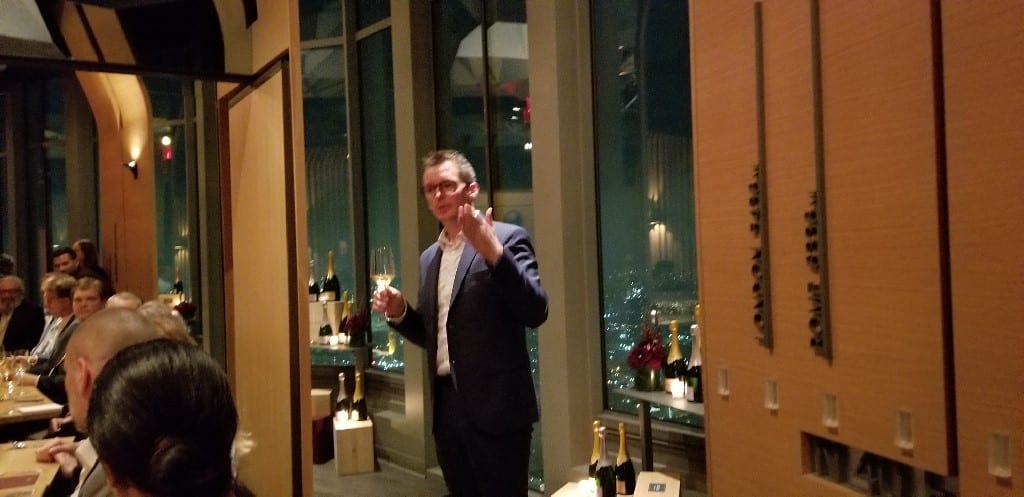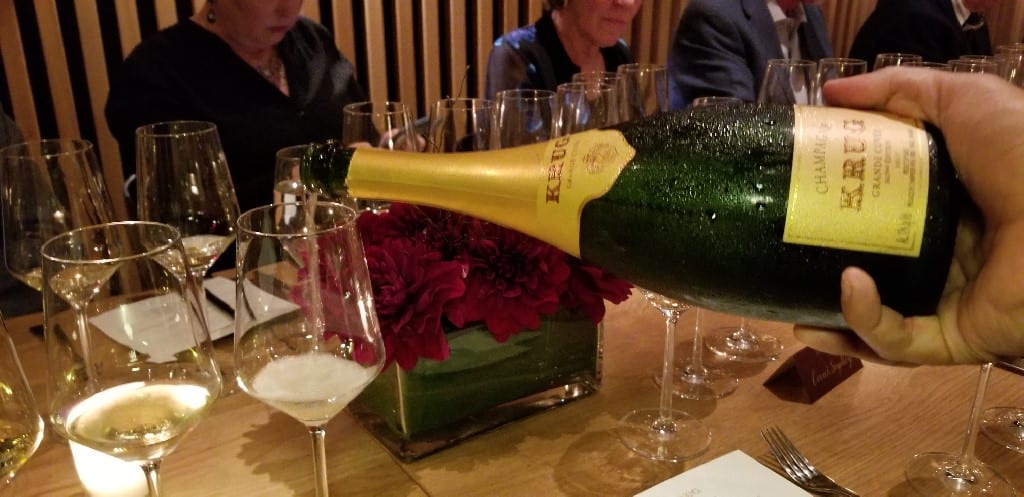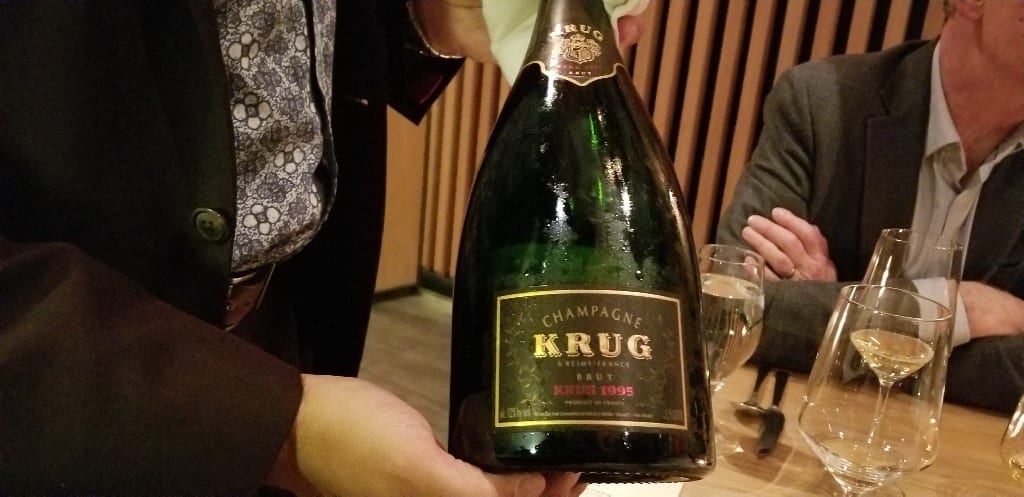

30 May An Evening of Pleasure with Krug Champagne
Drinking a glass of Krug Champagne is aspirational, sitting down for a dinner of Krug Champagne is beyond my wildest dreams. But, my dreams came true as I enjoyed a delicious meal at 71 Above in downtown LA, paired with more than a dozen bottles of Krug Champane which I wrote about in the Napa Valley Register and am sharing here.
Exclusive. Aspirational. Hedonistic. Revered. Indulgent. Pleasure. These are just some of the words that come to mind when I think about Krug Champagne. In fact, ask any Champagne collector, or lover, to name a brand that is respected the world over and they will likely answer Krug.
I have had the pleasure to taste Krug Champagne on a couple of occasions. Mind you, it was just a taste of the Grand Cuvee or the Rosé, but even with those tastes, I cherished every sip.
But at Effervescence, the Champagne and Sparkling Wine Festival the first weekend in May in Los Angeles, I luckily got a seat at the table at the Krug collector dinner. In full disclosure, I held the title of general manager of Effervescence, but never did I expect to have a seat at this intimate dinner. Luckily, I did get a seat and enjoyed an evening of pleasure with Krug Champagne and Jérôme Jacoillot, the winemaker in charge of Clos du Mesnil.
As we sat down for dinner, Jérôme welcomed the table. Young, friendly and exceptionally easy to talk to, Jérôme spoke about how Krug is somewhat of a unicorn in the wine world. The vision of German-born Joseph Krug, the house was founded in 1843. It was Krug’s dream to give the fullest expression of Champagne and for more than 170 years, the house of Krug has maintained that challenge. And it is a challenge.
Krug keeps each vineyard plot separate. Every year, the team of six winemakers has 250 different wines to taste. They will blind taste 15 wines each day, tasting every single wine and deciding where it will be best used. The process of tasting all of the wines can take approximately five months before the final blends are made. In addition to tasting every single wine to determine the blends, the team must think about how the wine will taste in the future.
The dinner started with the Krug Grande Cuvée 160th Edition en Jeroboam. Krug Grande Cuvée is not a vintage Champagne. It is a blend of Chardonnay, Pinot Noir and Pinot Meunier from more than 120 different base wines from 12 different vintages. The 160th Edition is based around the 2004 vintage with the oldest wine from 1990. To make a wine like the Krug Grande Cuvée requires patience, and the result is pleasure.
The first flight was the Krug Clos du Mesnil 2004 and the Krug Vintage 2004. The 2004 Clos du Mesnil is a single vintage and a single variety. It is a wine made with an obsession to detail. Clos du Mesnil is a 1.84-hectare (4.5-acre) plot. Jérôme tastes the grapes, and sometimes, based on exposure, splits the vineyard into as many as six different plots. Despite its small size, it takes 10 days to pick Clos du Mesnil.
The Krug 2004 Clos du Mesnil Brut Blanc de Blancs is fresh and elegant with aromas of citrus, white flowers and chalky notes. Jérôme describes the Clos du Mesnil as the soloist. If Krug Clos du Mesnil 2004 is the soloist, then Krug Vintage 2004 is the trio. Composed of Chardonnay, Pinot Noir and Pinot Meunier, the wine is elegant, fresh and dense with aromas of lime zest, apple, stones and spice. And to continue the musical references, the Krug Grande Cuvée 160th Edition would be considered the full orchestra.
The next flight was a vertical of six consecutive editions of Krug Grande Cuvée—161, 162, 163, 164, 165 and 166. This was the first time outside of the house of Krug to taste a vertical of the Grande Cuvée, with some of the editions being rare.
What is unique about the Grande Cuvée, compared to other houses and their non-vintage wines, is that the goal is not to make the same wine year after year. Each year, the winemaking team starts with a blank page. There is no recipe. Everything is based on taste. And tasting through the vertical of Grande Cuvée editions, it was clear that each one was unique. In fairness, I was enjoying going back and forth between each one and was remiss on taking any notes. It was just about pure pleasure. But I recall the 164th Edition to be a glass that I kept returning to.
After the six consecutive editions, the Krug Rosé 18th Edition en Magnum was poured. The rosé was an experiment created by brothers Henri and Rémi Krug in 1976. They made a red wine from Pinot Noir and blended the red and white wines as an experiment. It went into the cellar, and five years later was included in a blind tasting.
They were so impressed with the result that Krug began making rosé and the 18th Edition was crafted around the 2005 vintage. Krug makes one tank of their own red wine and the percentage added to the white wine depends on taste, not color.
Typically, there is 8 to 11 percent red wine. Too much red wine and you lose the elegance and freshness. A subtle pale pink color with aromas of red currant, grapefruit and pepper, the Krug Rosé will always be one of my favorites.
The piece de la resistance of the night was the opportunity to taste the newest release of the 1988 Krug Collection Champagne. Krug saves a portion of each vintage, allowing the wine to spend more time on the lees. Released later as a Krug Collection Champagne, 1988 is the newest release and we were the very first people in the U.S. to try it. Mature aromas and a waxy honey note, the wine, served in magnum, was rich and elegant and yet still fresh.
Just when I really did not think it could get any better, our glasses were filled Krug Vintage 1995 en Magnum and Krug Collection 1982 en Magnum. Each wine I sipped was one of utter pleasure, and as I think back on this wonderful evening sipping Krug Champagne, all I can think about is: exclusivity, aspirational, hedonistic, revered and indulgent. It was a rare dining experience and a true treat to enjoy an evening of pleasure with Krug Champagne.
Read the original story in the Napa Valley Register.











